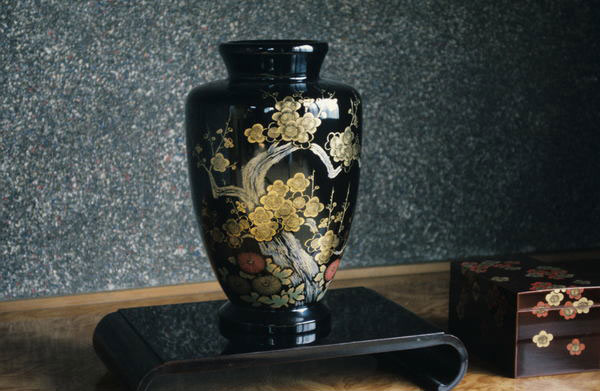 Photo:Wakayama Prefecture
Photo:Wakayama Prefecture
- Lacquerware
- Wakayama
Kishu lacquerware Kishu shikki
Lacquerware that evolves with time
A beauty useful in daily life
Description
What is Kishu lacquerware ?
Kishu lacquerware, also known as kuroe-nuri, is produced around the Kuro-e region northwest of the city of Kainan, Wakayama prefecture. This craft is simple, durable, and practical and has been popular as a household good since the Edo period (1603-1868). Kishu lacquerware is known for patterning made by the vermilion surface wearing away to reveal a black undercoat. This effect is said to have originated from negoro-nuri, made by the monks of Negoro-ji Temple in the nearby city of Iwade. Items such as dining tables, bowls, trays, and small shrines were produced for use at the temple. As the pieces were for daily use, they had a simple coating of vermillion lacquer over a black lacquer undercoat. Over time and with use, the vermillion lacquer surface would gradually wear away, revealing patches of the black lacquer undercoat. The unintentional nature of the process was considered part of negoro-nuri's charm.
In order to adapt to the needs of contemporary life, Kishu lacquerware artists have started producing lacquerware decorated with maki-e* designs and mass-produced plastic-based items, in addition to the traditional negoro-nuri style.
*Maki-e is a method that makes use of the adhesive quality of lacquer by sprinkling powder of gold, silver, or other colors like vermilion, yellow, or blue onto a lacquer drawing.
History
Kishu lacquerware is said to have started in the Muromachi period (1336-1573) when woodturners from the Kishu region (present day Wakayama) began producing shibuji (persimmon juice and lampblack) bowls. This craft was shaped and influenced by these shibuji bowls, in addition to practical negoro-nuri pieces made by monks. In 1585, due to feudal lord and warrior, Hideyoshi TOYOTOMI’s attack on Negoro-ji Temple, the monks who produced lacquerware were forced to leave and settle in Kuro-e, leading to the rise of lacquerware production around that area. Kishu lacquerware greatly developed as a household good during the Edo period under the financial sponsorship of the Kishu domain (present day Wakayama and southern Mie prefectures).
Subsequently, items such as dining tables were successfully produced in 1826, and articles decorated with maki-e designs started appearing around the years 1852-1860. Kishu lacquerware lost the financial backing of the Kishu domain following the Meiji Restoration in 1869, but gradually revived once full-scale trading with foreign countries started in the following year. Furthermore, chinkin* designs were introduced in 1879, and maki-e artists were invited from Kyoto to improve existing techniques in 1898. Many kawari-nuri or free patterning techniques were invented during the Showa period (1926-1989), thus continuing the development of Kishu lacquerware.
*Chinkin is a decorative technique where gold leaf is inserted into the grooves of dots or lines that have been carved with a knife.
General Production Process
- 1. Collection and production of lacquer
Bladed tools are used to make cuts on lacquer trees and the secreted lacquer sap is collected. The collected lacquer is then dehydrated, refined, and filtered to improve its luster and transparency.
- 2. Wood base production
Wood is processed to make wood bases. Each part of the piece is cut out from the wood and joined together. Then the base piece is shaved.
- 3. Base preparation
The lacquer coating process is divided into base preparation and coating processes. In the base preparation process, scratches on the wood base are mended, the surface smoothened and fragile parts are strengthened by pasting cloth or washi (traditional Japanese paper).
- 4. Coating
As the name suggests, the coating process involves coating lacquer onto the wood base and is divided into three steps: undercoating, intermediate coating and overcoating. Undercoating is done to improve the effect of overcoating and intermediate coating is applied to make the overcoat appear more refined and elegant. Once the undercoating is complete, the piece is placed to dry inside a drying cabinet, a highly humid shelving unit designed to dry lacquer while avoiding dirt and dust. Once dry, the item is polished to smooth the surface and improve the adhesion of the intermediate lacquer coat. Then, the item is again dried inside the drying cabinet after intermediate coating is complete. After drying, the piece is polished to smooth the surface and improve adhesion of the overcoat. The lacquer coating applied during overcoating is slightly thicker than the intermediate coating. After the piece is completely coated, it is turned over at fixed intervals to prevent the lacquer from flowing and pooling at the base.
- 5. Decorations
When the lacquer overcoat is sufficiently dried, the article is then decorated. Decorative techniques include maki-e, chinkin, raden and silk screen printing. Maki-e is when illustrations are drawn using lacquer and then gold, silver, or tin powder, or dried colored lacquer powder is sprinkled over top of the wet surface. For chinkin, patterns are engraved using a chisel, raw lacquer is rubbed into the grooves, and gold leaf is pasted onto the raw lacquer. Raden is when the inner linings of seashells are cut out and embedded into or pasted on the surface of the lacquerware. This technique was imported from China at some point in time. For the silk screen techniques, designs are spray-painted onto the surface instead of being hand-drawn like for maki-e, which enables the mass production of lacquerware.
Where to Buy & More Information
Kishu-Shikki Dento Sangyo Kaikan
-
Address
-
Tel.+81-73-482-0322
-
Closed2nd Sunday of the month, August 14-16, December 28-January 4
-
Business Hours10am to 4:30pm
-
Website
See more Lacquerware
- Wajima lacquerware
- Kamakura-bori lacquerware
- Tsugaru lacquerware
- Aizu lacquerware
- Yamanaka lacquerware
- Kawatsura lacquerware
- Echizen lacquerware
- Joboji lacquerware
- Kiso lacquerware
- Hidehira lacquerware
- Kagawa lacquerware
- Ryukyu lacquerware
- Takaoka lacquerware
- Wakasa lacquerware
- Hida-shunkei lacquerware
- Ouchi lacquerware
- Kanazawa lacquerware
- Kishu lacquerware
- Kyo laquerware
- Odawara lacquerware
- Naruko lacquerware
- Niigata lacquerware
- Murakami carved lacquerware































































































































































































































































































